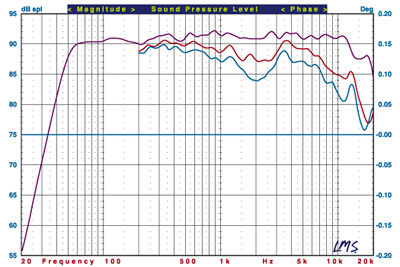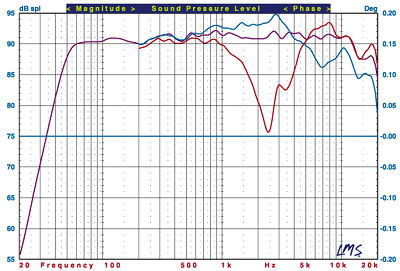Thiel CS1.6 speaker Measurements
All measurements were taken with the grille removed.
The impedance of the CS1.6 indicates that its ported cabinet is tuned to about 49Hz, with minimum impedances of 3.4ohms at 250Hz and 3.2ohms at 5.5kHz. We would rate the nominal impedance at about 4ohms. The impedance magnitude remains below 4ohms over most of the range above about 200Hz. While I would not judge the Thiel to be a particularly difficult load to drive, I would recommend that it be used only with amplifiers comfortable with loads under 4ohms. While the Thiel's very high sensitivity (about 92dB/W/m) should somewhat mitigate the disadvantages of its low impedance, if you plan to drive these speakers with a receiver, in particular, make certain it's comfortable driving low impedances.
The pseudo-anechoic response of the CS1.6 at tweeter height, averaged over a 30degrees forward horizontal angle and combined with the nearfield responses of the woofer and port, is shown in Fig.1 (violet). The bass is useful down to only about 39Hz (-10dB); for home theater applications, a good subwoofer is a must with these speakers. The overall response, however, is exceptionally flat and smooth over most of the frequency range.
Moving off-axis horizontally (Fig.1), the inevitable high-frequency rolloff is well controlled, even at 60degrees (blue), with a modest suck-out starting to appear at at 2kHz at a wide 60degrees angle.

Fig. 1
Fig.2 shows the same averaged horizontal front response (violet), plus the vertical responses taken at +15degrees (red) and -15degrees (blue) relative to the tweeter. The speaker is clearly at its best on or very near the tweeter axis; the first-order crossover networks used in all Thiel speakers, and the resulting overlap between drivers, make extreme off-vertical-axis angles problematical. Since the tweeter will be significantly below ear height in most installations (it is several inches below the top of the 35.5-inch-tall cabinet), you might try experimenting with a slight cabinet tilt-back if the balance sounds a little off. Thiel can provide optinal outrigger feet that not only facilitate this but also improve the speaker's stability.

Fig. 2
The day I wrote up these results we received September's issue of our sister publication, Stereophile, with a review of this same Thiel speaker. I found it interesting that where our measurements overlap theirs (Stereophile presents a somewhat different, and broader, set of tests than we do)—impedance, frequency response, bass extension, off-axis response—the two do not differ significantly. They rated the sensitivity 2dB higher than we do (at an astonishing 94dB/W/m), but apart from that, the two sets of results correlate closely. Interestingly, we use different test gear—LMS in our case, MLSSA for Stereophile. The fact that the measurements are so similar for two entirely different samples of the CS1.6 also speaks well of Thiel's quality control.—Thomas J. Norton
- Log in or register to post comments





























































